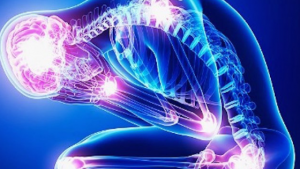
If you have a bent or curved penis, you may be dealing with Peyronie’s disease.
Between 1 and 23% of men over age 40 deal with Peyronie’s disease at some point. Although it’s a benign condition, it can be painful and make sexual intercourse unbearable.
And I’m a firm believer in the importance of sex for a happy and healthy life.
To ensure you are living to full sexual vitality, let’s take a look at the basics of Peyronie’s: what it is, what causes it, and how you can treat it to regain your sexual prowess.
What is Peyronie’s disease?
Peyronie’s is an inflammatory condition that causes the curvature or deforming of the penis. With the disease, the penis can be bent at an angle ranging from 10 to 90 degrees, and it can bend up, down, or to either side.
It’s normal for a man’s penis to curve slightly. If you have a bend in your penis, don’t panic, especially if you’ve had that bend your entire life.

Peyronie’s is when the penis bends due to an accumulation of fibrous scar tissue. So, in most cases, this is a new or unexpected bend in the penis.
But Peyronie’s is more than just a cosmetic concern. It can impact sexual performance and cause debilitating pain. A lot of men with Peyronie’s have so much pain that they can’t have sex.
(But not always. You can have Peyronie’s and still have a satisfactory sex life.)
Peyronie’s disease may also lead to high levels of stress and anxiety. That makes sense. It’s easy to get stressed if you look down and see your penis is bent…
But don’t stress yet. Peyronie’s is treatable—and it may even go away on its own!
What are the symptoms of Peyronie’s disease?
Peyronie’s onset can be sudden or gradual. You might wake up one day (with a morning erection) and see a bent, painful penis. Or you might find that over the course of a few months, your penis slowly stops straightening or functioning like it used to.
The top symptoms of Peyronie’s include:
- Bent or curved penis
- Penis pain during erection and orgasm (sometimes when flaccid as well)
- Lumps in the penis (cased by scar tissue)
- Erectile dysfunction
- Loss of penis length (sometimes)
Peyronie’s can sometimes cause erectile dysfunction as well. The bend in the penis can be so painful that it can make getting or maintaining an erection nearly impossible. It can also create performance anxiety due to self-image concerns. Learn more about the causes of erectile dysfunction here.
What causes Peyronie’s disease?
Peyronie’s occurs from a formation of scar tissue in the penis. Scar tissue forms as a healing response to some sort of injury. Thus, in most cases, Peyronie’s is caused by some sort of injury or trauma to the penis.
This “injury” can be a sporting accident, car accident, or even a sex incident.
The injury causes damage to the capillaries (small blood vessels) in the penis. The penis has two sponge-like tubes on either side called the corpus cavernosum. These are filled with capillaries that engorge with blood in order to have an erection. If the vessels are damaged, blood can’t flow to the penis for an erection.
Some scar tissue may form in order to heal these capillaries. If this scar tissue sticks around, it could lead to Peyronie’s disease.

The penis is surrounded in a casing of skin that’s elastic and flexible. This skin stretches when the penis is erect. However, if there’s scar tissue in the penis, the casing can’t stretch as far.
When the penis becomes erect, the skin has to stretch out to accommodate the erection. But the scarred part can’t stretch. Thus, the scarred part pulls down that side of the penis to keep it bent.
Scarring on the top of the penis will bend it upwards, scarring below will bend it downwards, and scarring on the side will bend it in that direction.
You’ll sometimes see scar tissue referred to as “plaque.” This simply means there’s a buildup of gunk in the penis, which is what’s causing it to bend.
However, there can be other cases of men with Peyronie’s who did not suffer trauma to the penis.
Risk Factors
There are other risk factors for Peyronie’s as well. For example, men with Dupuytren’s contracture, which is a connective tissue disorder, may often have concerns with Peyronie’s.
Age may also play a role, as it becomes harder for our bodies to heal as we age. (Even though most men with Peyronie’s are over age 40, about 8-10% of men with the disease are under age 40.)
Another potential risk factor for Peyronie’s is the treatment for prostate cancer, like a radical prostatectomy or radiation therapy. This is likely because treatment can obstruct the penile blood vessels. These incite the body to go through the healing process, which can include scarring—and scarring can cause Peyronie’s.
How do I know if I have Peyronie’s?
If you have any of the above symptoms, like a bent penis or pain with erection, or you recently had a trauma to the penis, it might be time to visit your doctor.
He will do a physical exam to measure the curvature of the penis. He will be able to identify the location and amount of scar tissue with the examination as well.
In some cases, you may need an ultrasound or X-ray to pinpoint how much and where the scar tissue is exactly located. This is especially important if you’ve elected to have surgery (which I’ll discuss below).
If you’re diagnosed with Peyronie’s disease, you have several options for treatment. This can help reduce pain and make sex possible—and enjoyable—once again.
Keep in mind that the first six months of Peyronie’s symptoms are the most painful. Usually, though, the pain will start to go away without treatment. Because of this, a lot of doctors will wait for 6 to 12 months before attempting to treat Peyronie’s. It’s preferable to wait and see if your body will heal the plaque on its own.
If not, you’ll then have a discussion about treatment options.
How is Peyronie’s treated?

Medication
Most medications for Peyronie’s are injected directly into the penis, not ingested.
There is only one FDA approved medication for Peyronies. Xiaflex, clostridium hystolyticum, is a series of penile injections that help breakdown the buildup of collagen. This can “loosen the gunk” in your penis to return it to its natural elasticity. It’s typically only recommended or prescribed for men with a curvature of more than 30 degrees.
Some doctors will prescribe interferon, which helps break down the fibrous tissue. It may also help reduce swelling and pain.
Verapamil is another possible option. This is a hypertension therapy medication that stimulates the activity of collagens, which plays a role in wound healing.
Keep in mind that these injection medications put a new incision in the penis. This perforation itself requires healing—which could further cause the growth of scar tissue. And scar tissue can lead to Peyronie’s.
Anti-inflammatories
Anti-inflammatories are a type of medication usually taken orally. Some are prescription but many are over-the-counter. The goal of anti-inflammatory medication is to reduce pain and discomfort associated with Peyronie’s. These usually can’t reduce scarring or fix the curve, though.
If you have only a slight curve, your doctor might prescribe anti-inflammatories to temporarily relieve discomfort. When the pain goes away, you may not need treatment if the curve isn’t that severe.
Shockwave therapy
Doctors have started to use shockwave therapy as a means of breaking up scar tissue. This hasn’t been proven as a continuous success, but it works for some patients.
How does shockwave therapy work? Imagine the Hulk just pounded his fist on the ground near a building. The building shakes a bit but stays intact. However, some of the coffee cups fell off the desks, some of the chairs fell over, and some of the ceiling tiles broke loose.

This is how shockwave therapy works (sort of). It uses waves to break up the scar tissue inside to help rid the body of backup and plaque.
Iontophoresis
Iontophoresis uses a weak electrical current to deliver medication through the skin. This allows the medication to be delivered in a targeted area of the penis without an incision. This is only in the trial phases and hasn’t proven successful yet.
Vacuum Devices
Some doctors will use a vacuum device to pull the penis outwards. This helps break up the tissue and straighten the penis. Vacuum devices are sometimes used in the treatment of erectile dysfunction as well.
However, it’s important to note that vacuum devices have a high rate of injury, meaning you could actually worsen your Peyronie’s if the vacuuming doesn’t go well.
Penile therapy
You may need to put your penis through therapy to help rehabilitate it back to life. Therapy is especially recommended for patients taking medication like Xiaflex.
There are two penis exercises that can help get rid of pain and scarring.
When not erect, stretch the penis by gently pulling on it. Do this three times daily for thirty seconds each. This can help break up scar tissue in a temperate way.
You can also gently straighten your penis when experiencing a spontaneous erection. If your penis is curving to the left, pull it gently to the right during erection and vice versa. Do this for 30 seconds once daily.
Nesbit procedure
The Nesbit procedure is the most recommended surgery for Peyronie’s. The doctor will remove or pinch the tissue where there’s scarring or plaque. This gets rid of the tissue, which frees the penis to bend and flex as it used to.
Although it’s the most successful reconstructive procedure, it also causes a shortening of the penis. Thus, it’s usually reserved for men who have adequate length, don’t suffer from erectile dysfunction, and don’t have any other nonsurgical options.
Vein graft
Some doctors will do a plaque incision with a vein graft. This is especially common for shorter penises, those with a more severe curve, or those with an hourglass shape. This procedure puts an incision in the plaque and then grafts a vein in that area.
In this procedure, the surgeon may actually change the size of your penis. They might shorten the unaffected side, which pulls the penis back to be even on both sides. But this will shorten the length of the penis.
They may also lengthen the affected side where there’s scar tissue; they do this by creating cuts and grafts in the tissue. But this has a higher risk of impotence.

I don’t usually recommend these for my patients. There is a high risk for loss of sensation and erectile function, and it may cause an irreversible shortening of the penis. Plus, the body may again create more scar tissue around that incision, causing the Peyronie’s problem again.
Prosthetic implant
You can put an implant in your penis, like those used for erectile dysfunction. This can help strengthen the curve of the penis while increasing the hardness of erections.
The implant is put in the spongy tissue that gets filled with blood during sexual arousal.
There are two types of implants. The permanent implant creates a semi-rigid penis; this can be cumbersome in daily life, but it’s enough for sexual intercourse. The inflatable implant is activated by a pump and creates a more natural erection, but you have to pump it in your penis right before having sex. This isn’t always the sexiest foreplay.
Nevertheless, implants can help improve rigidity and curvature without impacting the length of the penis or creating new incisions that require healing.
Lifestyle changes
It’s also important to note that lifestyle changes have a positive impact on Peyronie’s disease. There is a link between lifestyle changes that are used to treat erectile dysfunction and treatment of Peyronie’s. For example, quitting smoking and exercising more frequently may be able to help the body better heal.
Learn more about treating your ED and Peyronie’s with lifestyle changes here.

Other treatments
Researchers are looking at other treatment methods as well, but these aren’t proven yet. For example, one study found that coenzyme Q10 can reduce penile curvature and another study found that acetyl-l-carnitine could help treat early Peyronie’s disease.
Vitamin E is another natural potential solution for Peyronie’s. It’s somewhat controversial, but I’ve seen success with a number of my patients using vitamin E as it helps to minimize pain and reduce plaque buildup. I will often recommend it to my patients because it’s cheap and easy–and it’s a necessary vitamin that everyone needs!
Is Peyronie’s curable?
Peyronie’s can be curable, but not always. Medication and surgery can show great results, but for some men, there is no permanent cure. Nevertheless, treatments can reduce pain and improve quality of life.
With certain treatments, you can have a more satisfying sexual performance and improved self-esteem, once again.
Bottom line
Peyronie’s disease is treatable. There are a number of options to help manage your pain and restore your sexual function.
You can and should have a healthy, happy sex life.
You deserve it.
If you want to restore your sex life to its youthful vigor, sign up for our G1 Performance Health program.
With an G1 Performance Health Consult, I’ll give you lifestyle changes that can help rejuvenate your sex life and health in weeks.
Don’t wait to have the healthy, sexy life you’ve dreamed of.













 In Male 2.0™, Dr. Tracy Gapin has turned everything we once thought we knew about men’s health and performance upside down. The old model of how to be “a man” is broken. A man who works himself to death. Unfortunately, a man who tries to NOT get sick but isn’t really healthy either. And a man who takes a pill for every ill but is never really cured. That was Male 1.0. Now, imagine being THE MAN ─ owning your performance in the bedroom, the weight room, and the boardroom. Living a fully optimized life. Becoming limitless. This is Male 2.0!
In Male 2.0™, Dr. Tracy Gapin has turned everything we once thought we knew about men’s health and performance upside down. The old model of how to be “a man” is broken. A man who works himself to death. Unfortunately, a man who tries to NOT get sick but isn’t really healthy either. And a man who takes a pill for every ill but is never really cured. That was Male 1.0. Now, imagine being THE MAN ─ owning your performance in the bedroom, the weight room, and the boardroom. Living a fully optimized life. Becoming limitless. This is Male 2.0!